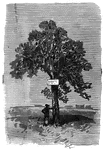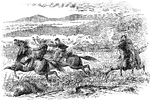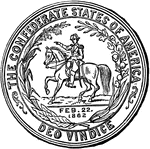The Miscellaneous Civil War ClipArt gallery includes 181 illustrations of general topic from the American Civil War, fought between the North (Union) and the South (Confederacy).
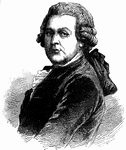
Charles Francis Adams
(1807-1886) Diplomat and member of the House of Representatives. He was able to lobby to keep Britain…
!["A detachment of the First South Carolina [African American] Federal Volunteers, under command of Colonel Beard, in the United States transport steamer <em>Darlington</em>, picking off Confederate sharpshooters concealed in the trees on the banks of the Sapelo River, Ga."— Frank Leslie, 1896](https://etc.usf.edu/clipart/11600/11647/aa-volunteer_11647_mth.gif)
African American Volunteers
"A detachment of the First South Carolina [African American] Federal Volunteers, under command of Colonel…
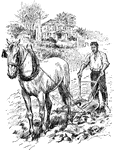
After Appomattox
The Appomattox Campaign (March 29, 1865 – April 9, 1865) was a series of battles fought in Virginia…

Attack of the Gunboats at Fort Donelson
Attack of the gunboats at Fort Donelson, one of the most influential battles in American history. This…
!["[African American] drivers of the baggage train attached to General Pleasonton's Cavalry brigade watering their mules in the Rappahannock. General Pleasonton's cavalry was attended by a very efficient forage brigade, consisting of mules and [African American] riders. Our sketch represents their drivers taking them to water at the river. The hard work these animals will endure is something wonderful, and justifies the high estimation in which they are held in the army." — Frank Leslie, 1896](https://etc.usf.edu/clipart/11000/11025/baggagetrain_11025_mth.gif)
Baggage Train
"[African American] drivers of the baggage train attached to General Pleasonton's Cavalry brigade watering…
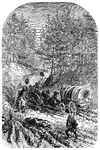
Federal Baggage Train
"Federal baggage train on its way to the army at Falmouth, VA., December, 1862. Our illustration represents…

Baggage Train Wagon
"Federal baggage train on its way to the army at Falmouth, VA., December, 1862. Our illustration represents…
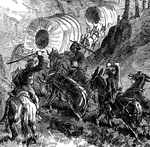
Baggage Train to Falmouth, VA
"Federal baggage train on its way to the army at Falmouth, VA., December, 1862. Our illustration represents…

Battle of Ball's Bluff
The Battle of Ball's Bluff is also known as the Battle of Harrison's Island or the Battle of Leesburg,…

Battle of Ball's Bluff
The Battle of Ball's Bluff is also known as the Battle of Harrison's Island or the Battle of Leesburg,…

Gunboats at the Battle of Baton Rouge
Gunboats at the Battle of Baton Rouge, also known as Magnolia Cemetery, was a ground and naval battle…
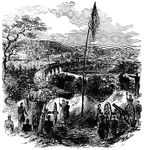
Bouquet Battery
"The Bouquet Battery, commanding the viaduct over the Patapsco River, on the Baltimore and Ohio Railroad,…

Battle of Belmont
The Battle of Belmont was fought on November 7, 1861 in Mississippi County, Missouri. This battle was…

Irish Brigade
"The Irish Brigade to the Rescue." The Irish Brigade was an infantry brigade made up of mainly Irish…
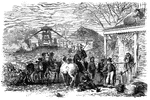
Bummers
"Sherman's 'Bummers' foraging in South Carolina. Our artist sent us with this sketch of 'Bummers Foraging'…

Burlesque Dress Parade
"Soldiers participating in a burlesque dress parade. Thanksgiving festivities at Fort Pulaski, Ga.,…

Burnard's House
Alfred Burnard's house stood two miles below Fredericksburg, near the river. The Englishman's estate…
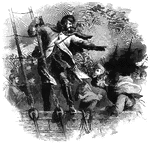
Burnside Expedition
"Burnside Expedition- the fleet and transports off Hatteras during the storm- the general giving orders.…

Burnside Expedition
"The Burnside Expedition- melancholy deaths of Colonel J. W. Allen, Surgeon Waller and the Second Mate…
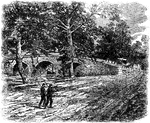
Burnside's Bridge
Burnside's Bridge is a landmark on the Antietam National Battlefield near Sharpsburg, Maryland. During…
Burnside's Corps
"The war in Virginia. Burnside's corps charging the Confederate position on the right of the enemy's…

General Butler Declaring African Americans "Contraband of War"
The controversial General Benjamin Franklin Butler declares that the African Americans are "contraband…

Caissons and Horses
"The war in Virginia. Caissons and horses on the field at Bristoe Station."— Frank Leslie, 1896

Cannon Dismounted
"Siege of Vicksburg- cannon dismounted inside the Confederate works."— Frank Leslie, 1896
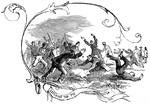
Catching the Pig
"Soldiers playing 'catch the pig.' Thanksgiving festivities at Fort Pulaski, Ga., Thursday, November…

Civil War Banner in South Carolina
"Street banner in Charleston, before the Civil War began."—E. Benjamin Andrews 1895

Civil War Musical Entertainment
"Extempore musical and terpischorean entertainment at the United States arsenal, Baton Rouge, La., under…
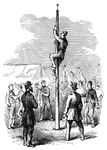
Climbing Pole
"Soldiers climbing up a greased pole. Thanksgiving festivities at Fort Pulaski, Ga., Thursday, November…
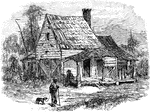
Battle of Cold Harbor
This sketch depicts the famous New Cold Harbor where the Battle of Cold Harbor took place. This was…
Confederate Army
"The Confederate army, under early, surprising the Federal forces at Cedar Creek, on the morning of…

Confederate Batteries
"Fredericksburg, Va., and the Confederate batteries and pickets, as seen from Falmouth Heights, headquarters…

A Confederate Blockade-Runner
The British ran a blockade of Southern ports with vessels carrying arms, ammunitions, and other supplies…

Confederate Cavalry
"Confederate cavalry driving stragglers and skulkers back to their duty at the Battle of Antietam. One…

Confederate Position
"Confederate position near Centreville, Va., at the crossing of the Orange and Alexandria Railway over…
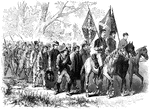
Confederate Prisoners
"Confederate Prisoners brought in after the Battle of Chancellorsville."— Frank Leslie, 1896
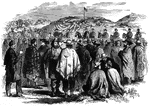
Confederate Prisoners
"Group of Confederate prisoners captured at Fort Donelson, on the morning after the surrender, clothed…

Confederate rams
"Confederate rams from Charleston Harbor attacking the Federal blockading squadron, January 31st, 1863.…

Confederate Rosette and Badge
The Confederate rosette and badge was worn by supporters of the Southern Confederation.

Confederates Crossing the Potomac
This sketch depicts the Confederates crossing the Potomac during the Maryland Campaign or the Antietam…

Conrad's Ferry
"Conrad's Ferry, Md., above Harrison's Island, on the Potomac River, the place of passage of Colonel…
!["A New Year's Day Contraband Ball at Vicksburg, Miss. The [African Americans] preserve all their African fondness for music and dancing, and in the modified form which they have assumed here have given rise to [African American] dancing and melodies in our theatres, a form of amusement which has enriched many."— Frank Leslie, 1896](https://etc.usf.edu/clipart/11600/11644/contra-ball_11644_mth.gif)
Contraband Ball
"A New Year's Day Contraband Ball at Vicksburg, Miss. The [African Americans] preserve all their African…
!["The war in Virginia- contrabands coming into the Federal camp. The [African American] furnishes, in his various phases of existence, wonderful studies for the artist and philosopher. Never, perhaps, has a race seen such a moment as during the Civil War, when the chains of bondage were breaking from the limbs of 4,000,000 of men. The distant roar of battle was to them a sound of deliverance. With all the uncouth, odd and queer manifestations of joy they prepared to reach the camp of the delivering Yanks. Yoking together most incongruous teams before the farm wagons of their fled masters, with ass and ox and horse, with household gear queerly assorted, with useless truck and little that could rarely serve them, they started for the Promised Land, and might often have been seen coming in as our artist, a most close student of nature, depicted them, with his usual felicity of portraiture."— Frank Leslie, 1896](https://etc.usf.edu/clipart/11700/11752/contrabands_11752_mth.gif)
Contrabands
"The war in Virginia- contrabands coming into the Federal camp. The [African American] furnishes, in…

Cumberland Army
"The army of the Cumberland- Wilder's mounted infantry passing a blockhouse on the Nashville and Chattanooga…

General Custer
General George Armstrong Custer with a Union spy. Custer is most known for his "last stand" at the Battle…
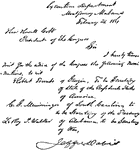
Jefferson Davis's First Message
Jefferson Davis', the President of the Confederate States of America, first message.

Fac-smile of General John A. Dix's Dispatch
John Adams Dix, of New York, was appointed Secretary of the Treasury. He sent Mr. Jones to New Orleans…

Encampment of Colonel Max Weber's Rifle Regiment
"Encampment of Colonel Max Weber's German Turner Rifle Regiment, Twentieth New York Volunteers, at Hampton…
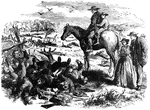
Farmers Visiting
"Maryland and Pennsylvania farmers visiting the battlefield of Antietam, while the Federal troops were…

